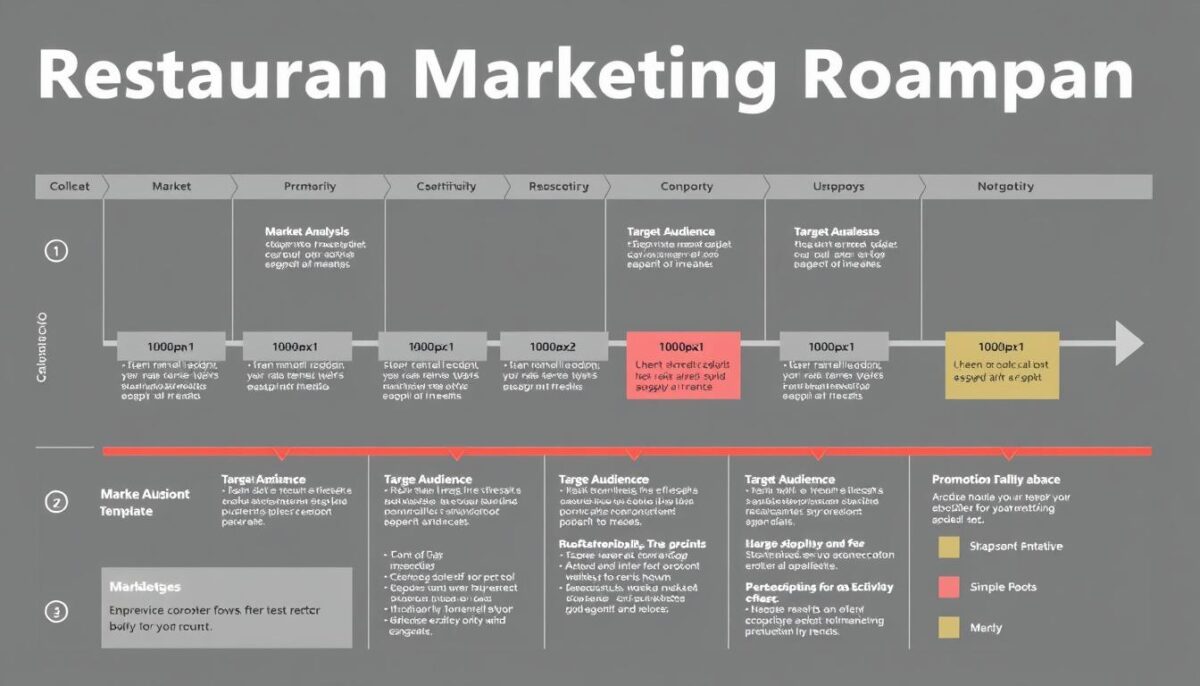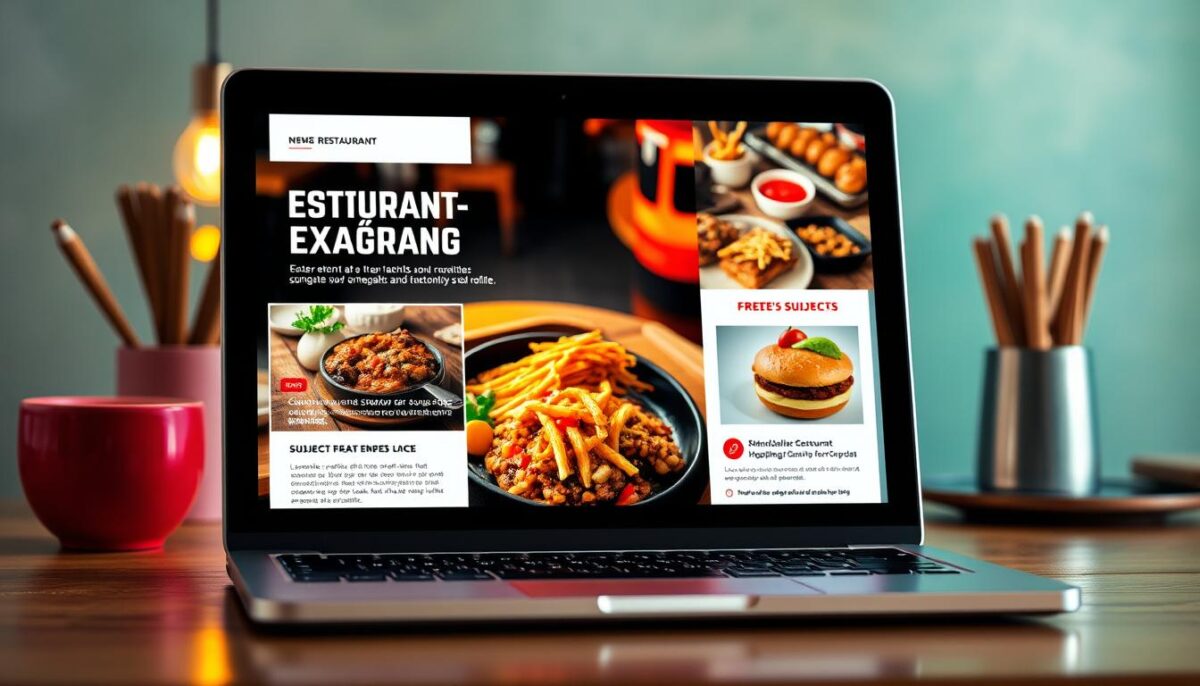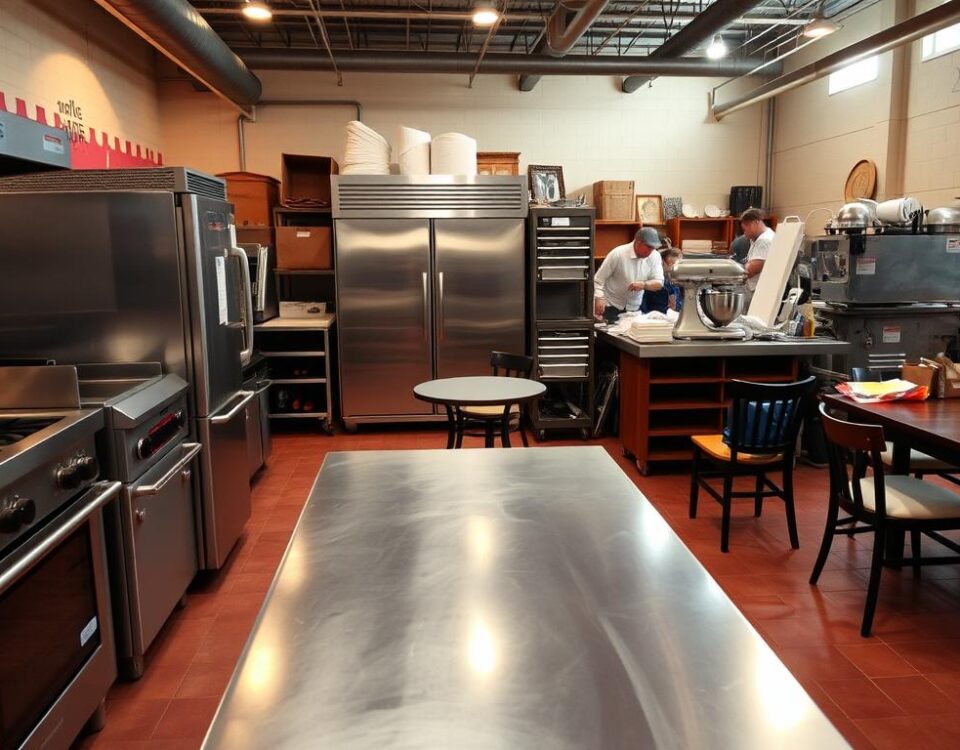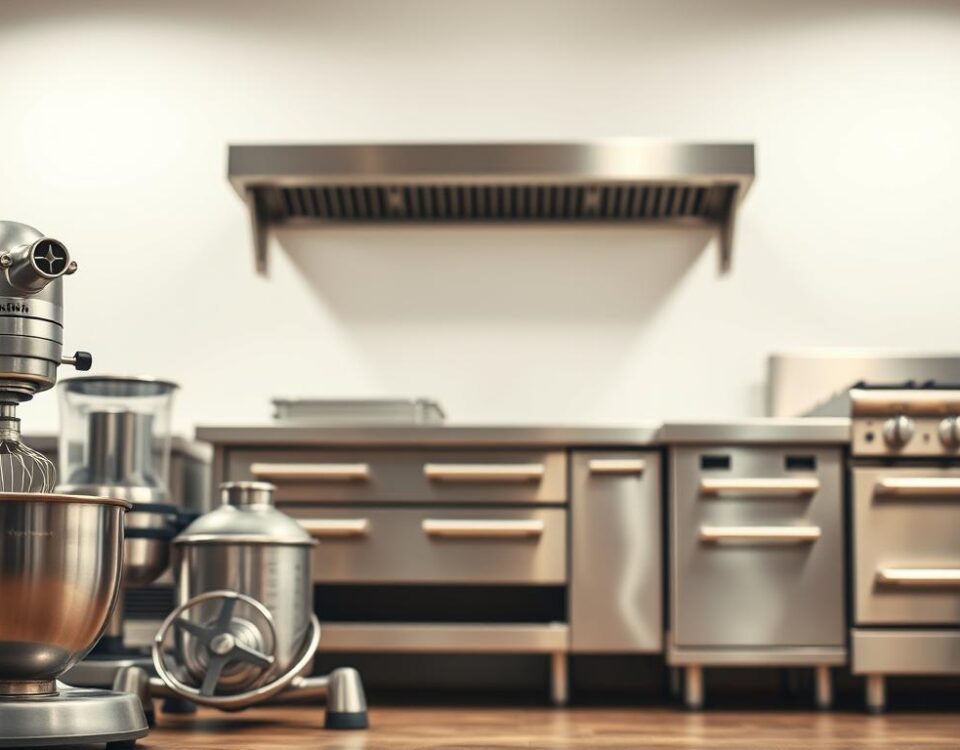
How to Price Restaurant Menus Using New York Produce Costs
August 16, 2025
What Every Chef Buys at NYC’s Terminal Market—Insider’s List
August 17, 2025I’ve seen many restaurant owners struggle to attract new customers despite serving great food. The truth is, having a great dish is just the starting point; you need a solid business strategy to stand out in a crowded market.
Did you know that nearly 60% of diners choose a restaurant based on online reviews? This statistic highlights the importance of having a comprehensive marketing plan in place. By implementing the right marketing strategies, you can increase your customer base and boost sales.
As someone who has helped numerous restaurants achieve significant growth, I’m excited to share my proven marketing roadmap that can help you attract more customers and drive business success.
Key Takeaways
- Develop a comprehensive marketing plan tailored to your restaurant’s needs
- Improve your online presence through reviews and social media
- Create effective loyalty programs to retain customers
- Implement strategies to increase customer engagement
- Monitor and adjust your marketing efforts for optimal results
The State of Restaurant Marketing in 2023
The year 2023 marks a significant shift in restaurant marketing strategies. As a restaurant owner, understanding these changes is crucial to staying competitive. In this section, we’ll explore the current state of restaurant marketing and how you can adapt to the new landscape.
Why Traditional Marketing No Longer Works Alone
Traditional marketing methods, such as print ads and direct mail, are no longer sufficient on their own. Today’s successful restaurants are embracing a hybrid approach that combines traditional marketing tactics with robust digital strategies. The pandemic has accelerated digital adoption in the restaurant industry, forcing businesses to pivot quickly to online ordering, delivery services, and enhanced digital presence.
Over 90% of diners research restaurants online before visiting, making your digital presence more critical than ever before. Social proof through reviews and social media has become a primary factor in diners’ decision-making process, outweighing traditional advertising in many cases.
| Marketing Channel | Pre-Pandemic Importance | Current Importance |
|---|---|---|
| Traditional Marketing | High | Medium |
| Digital Marketing | Medium | High |
| Social Media | Low | High |
The Digital Transformation of Restaurant Marketing
The restaurants seeing the greatest success are those that have embraced this digital transformation while maintaining the personal touch that makes dining special. To achieve this balance, you need to understand multiple channels and touchpoints where customers interact with your brand before making dining decisions.
By combining traditional marketing efforts with digital strategies, you can create a comprehensive approach that drives real results. I’ll show you how to leverage digital marketing to boost your restaurant’s sales and customer engagement.
In conclusion, the state of restaurant marketing in 2023 requires a blend of traditional and digital strategies. By understanding the changing landscape and adapting your marketing approach, you can attract new customers and retain existing ones.
Understanding Your Restaurant’s Current Position
Assessing your restaurant’s current position is a fundamental step in devising effective marketing strategies. Before implementing any new initiatives, it’s essential to take a step back and honestly evaluate where your restaurant stands in the marketplace.
A comprehensive SWOT analysis is a valuable tool for this assessment. SWOT stands for strengths, weaknesses, opportunities, and threats. This analysis helps identify your restaurant’s internal strengths and weaknesses, as well as external opportunities and threats.
Conducting a SWOT Analysis for Your Restaurant
To conduct a SWOT analysis, start by identifying your restaurant’s strengths. These might include signature dishes, exceptional service, a prime location, or a loyal customer base. Your strengths are assets to leverage in your marketing efforts.
Next, consider your restaurant’s weaknesses. These could be limited parking, outdated decor, inconsistent food quality, or poor online reviews. Identifying weaknesses helps you address areas that need improvement.
| SWOT Analysis Component | Description | Example |
|---|---|---|
| Strengths | Internal attributes that support your restaurant’s success | Signature dishes, exceptional service |
| Weaknesses | Internal attributes that hinder your restaurant’s success | Limited parking, outdated decor |
| Opportunities | External factors that your restaurant can capitalize on | Emerging food trends, untapped customer segments |
| Threats | External factors that could negatively impact your restaurant | New competitors, changing consumer preferences |

Identifying Your Unique Selling Proposition
Your unique selling proposition (USP) is what sets your restaurant apart from the competition. It might be your chef’s background, a secret recipe, your atmosphere, or your commitment to local sourcing. Restaurants with clearly defined USPs have an easier time creating focused marketing messages that resonate with their target audience.
By conducting a thorough SWOT analysis and identifying your USP, you’ll be well-equipped to develop a marketing plan that drives real business growth and boosts your restaurant’s sales.
Setting S.M.A.R.T Marketing Goals
In the competitive restaurant industry, establishing clear S.M.A.R.T marketing objectives is vital. As you set goals, make sure they follow a S.M.A.R.T. framework: Specific, Measurable, Achievable, Relevant, Time-bound.
Specific and Measurable Objectives
Setting specific and measurable objectives is crucial for your restaurant’s marketing success. Specific goals might include increasing weekday lunch traffic by 25%, boosting average check size by $8, or growing your email list to 5,000 subscribers. Measurable objectives allow you to track progress through concrete metrics such as daily sales figures, reservation numbers, website traffic, or social media engagement.
Creating Achievable and Time-Bound Targets
Achievable goals consider your restaurant’s current position and resources, ensuring that targets are ambitious yet realistic. Relevant goals align with your overall business strategy; for instance, if you’re a fine dining establishment, focusing on private event bookings might be more relevant than delivery volume. Time-bound targets create urgency and accountability by specifying exactly when you expect to achieve each goal.
| Goal Type | Example | Timeframe |
|---|---|---|
| Specific | Increase weekday lunch traffic by 25% | 90 days |
| Measurable | Boost average check size by $8 | 6 months |
| Achievable | Grow email list to 5,000 subscribers | 12 months |
By setting S.M.A.R.T marketing goals, your restaurant can create a clear roadmap to success, ensuring that marketing efforts are focused and effective.
Building a Strong Brand Identity
A well-crafted brand identity is vital for restaurants seeking to stand out and attract a loyal customer base. In the competitive restaurant industry, a strong brand can be the difference between a customer choosing your establishment over another.

Defining Your Restaurant’s Mission and Values
Your restaurant’s mission statement should clearly articulate why you exist beyond making a profit. Perhaps it’s to preserve traditional recipes, bring a community together, or introduce innovative cuisine to your area. Core values guide every decision in your restaurant, from menu development to hiring practices to marketing messages. They’re the principles you won’t compromise on.
For instance, if sustainability is one of your core values, this could influence your sourcing practices, menu offerings, and even the design of your restaurant’s physical space. By staying true to your mission and values, you create a consistent brand image that resonates with your target audience.
Creating a Memorable Visual Identity
Visual identity elements include your logo, color palette, typography, photography style, and design elements. These should work together to create instant recognition. I recommend creating a simple brand style guide that ensures consistency across all marketing materials, from your menu to your website to your social media profiles.
Your restaurant’s physical space should be an extension of your brand identity. The interior design, music, lighting, staff uniforms, and even restroom decor should reinforce your brand story. The most successful restaurant brands evoke specific emotions and create memorable experiences that customers want to share with others.
Remember, your brand identity isn’t just what you say about yourself; it’s ultimately defined by how customers perceive and talk about your restaurant. By focusing on creating a strong, consistent brand identity, you can build a loyal customer base and drive business growth.
Identifying and Understanding Your Target Audience
Knowing your target audience inside and out is the key to creating effective marketing strategies for your restaurant. A key aspect of your brand is your ideal target customer. Marketing will be much more successful if it’s honed to the particular demands, desires, and preferences of the customers who are most likely to order from your restaurant.
Customer Demographics and Psychographics
Understanding your target audience begins with analyzing your current customer base – who’s already coming to your restaurant and why do they choose you over alternatives? Demographics include age, income level, education, occupation, family status, and location – these factors influence dining preferences and spending habits.
- Age and income level can significantly impact dining choices and frequency.
- Education and occupation can influence the type of cuisine and dining experience preferred.
- Family status and location play a role in determining the convenience and ambiance required.
Psychographics dig deeper into values, interests, lifestyles, and behaviors – understanding why people dine out and what they’re looking for in the experience.
- Values such as sustainability or health consciousness can drive menu choices.
- Interests in culinary experiences can lead to preferences for unique or exotic cuisine.
- Lifestyles, such as busy professionals, can demand convenience and efficiency.
Creating Customer Personas for Your Restaurant
I recommend creating 3-5 detailed customer personas that represent your ideal guests – give them names, backgrounds, and specific motivations for visiting your restaurant. For example, “Professional Pam” might be a 35-year-old executive who values efficiency and quality, visits for business lunches, and appreciates online reservation options.
- “Foodie Fred” might be a 28-year-old enthusiast who seeks unique culinary experiences, shares extensively on social media, and is willing to pay premium prices for innovation.
- Your marketing messages, channels, and timing should be tailored to reach these specific personas where they are, with messages that resonate with their particular needs.
Remember that your target audience may evolve over time – regularly revisit your personas to ensure they still represent your ideal customers. By understanding and catering to your target audience, you can significantly boost your restaurant’s sales and enhance customer loyalty.
Developing Your Restaurant Marketing Roadmap

To achieve significant growth, your restaurant needs a comprehensive marketing roadmap. This roadmap will serve as your action plan, guiding your marketing efforts over the next 12 months. It’s essential to have detailed activities planned for the first quarter, with broader goals set for the subsequent quarters, allowing for flexibility while maintaining direction.
Step-by-Step Planning Process
The first step in creating your marketing roadmap is to identify key seasons, holidays, and local events that impact your restaurant business. These events will become crucial anchors in your marketing calendar. Next, break down your roadmap into specific campaigns with clear objectives, timelines, responsible parties, and success metrics. This structured approach ensures that your marketing efforts are focused and effective.
For instance, if you know that your restaurant experiences a surge in customers during the holiday season, you can plan targeted marketing campaigns around this time. Similarly, if there’s a local event that attracts a large crowd, you can tailor your promotions to capitalize on this opportunity.
Allocating Budget and Resources Effectively
Allocating your marketing budget effectively is crucial. I recommend setting aside a percentage of your projected revenue for marketing – typically 3-6% for established restaurants and 10-15% for new restaurants. Your budget allocation should reflect your priorities; if social media drives most of your business, invest more heavily there than in traditional advertising.
Resources aren’t just financial; consider who on your team will execute various marketing tasks, what skills you need to develop or outsource, and what tools you’ll need. A successful marketing roadmap includes a mix of ongoing activities, like social media and email marketing, and special campaigns, such as seasonal promotions. Regular review points should be built into your roadmap to assess what’s working and what isn’t, allowing you to adjust based on results and changing market conditions.
By following this structured approach to developing your restaurant marketing roadmap, you’ll be well on your way to creating a robust marketing strategy that drives growth and boosts sales.
Optimizing Your Restaurant’s Online Presence
As a restaurant owner, your online presence is often the first impression potential customers have of your business. This is why having a clean, clear, and easy-to-navigate website is crucial. By not being online, you lose reach and exposure, meaning you lose potential business.
Building an Effective Restaurant Website
Your website should be mobile-friendly, fast-loading, and include essential information like your menu, hours, location, and reservation/ordering capabilities. I recommend investing in professional food photography for your website, as high-quality images of your dishes significantly impact customers’ decisions to visit.
When choosing a restaurant website builder, consider options that offer customizable templates, easy menu management, and seamless integration with online ordering systems.
Claiming and Optimizing Google Business Profile
Your Google Business Profile is perhaps the most important online listing, as it appears in search results and maps, providing crucial information to potential customers. Claim and verify your Google listing, then optimize it with accurate information, business categories, attributes, photos, and regular posts about specials or events.
Managing Online Reviews and Reputation
Online reviews can make or break your restaurant, with studies showing that a half-star increase in ratings can boost business by 5-9%. Develop a proactive strategy for generating positive reviews from satisfied customers, and respond to all reviews, both positive and negative, in a professional and timely manner.
I’ve found that restaurants that respond to at least 25% of their reviews see higher engagement and better overall ratings over time. Remember that your online presence extends beyond your own properties to include third-party sites like Yelp, TripAdvisor, and delivery platforms – monitor and manage these consistently.
Creating a Social Media Strategy That Drives Traffic

Developing a social media strategy that resonates with your target audience is key to increasing foot traffic. As a restaurant owner, you need to understand that social media is a crucial channel in your marketing strategy. By leveraging platforms like Instagram, TikTok, and Facebook, you can raise awareness about your business and attract new customers through captivating pictures and videos of your dishes, events, and behind-the-scenes moments.
Choosing the Right Platforms for Your Restaurant
Rather than trying to be everywhere, focus on the platforms where your target audience is most active. For visual content, Instagram and TikTok are ideal, while Facebook is better suited for community and events. LinkedIn can be utilized for B2B and corporate catering. By concentrating on the right platforms, you can maximize your reach and engagement.
Content Creation Tips for Restaurants
Each platform requires different content approaches. Instagram thrives on beautiful food photography, TikTok rewards authentic behind-the-scenes content, and Facebook works well for events and community engagement. To create a balanced content calendar, allocate 20% for promotional posts, 30% for educational content, 30% for entertaining content, and 20% for engagement posts. Remember to follow the 80/20 rule, where 80% of your content provides value to followers, and only 20% directly promotes your restaurant.
Leveraging User-Generated Content and Influencers
User-generated content is gold for restaurants. Encourage customers to share their experiences by creating “Instagrammable” moments in your space and using branded hashtags. Micro-influencers with 5,000-50,000 followers often drive better results for local restaurants than celebrities. Look for food influencers with engaged local audiences to promote your brand. Consistency is crucial, so post regularly (3-5 times per week) to maintain a strong online presence.
Track which types of posts drive actual business results, such as reservations and orders. Respond to comments, engage with followers, and build relationships with your online community to foster a loyal customer base. By implementing these strategies, you can create a social media presence that drives traffic and boosts sales.
Email Marketing Campaigns That Convert

The power of email marketing lies in its ability to directly influence customer dining choices. In fact, 59% of people say that an email can influence where they decide to eat.
Despite the rise of social media, I’ve consistently found email marketing to be the highest ROI channel for restaurants – with returns often exceeding $40 for every $1 spent.
Building Your Email Subscriber List
Building a quality email list starts with offering genuine value in exchange for contact information. This might be a first-time discount, a free appetizer, or exclusive content.
I recommend using multiple touchpoints to collect emails: your website, in-store signage, QR codes on receipts, reservation systems, online ordering platforms, and wifi login portals.
Creating Engaging Email Content and Offers
Your email content should be 80% value and 20% promotion – share recipes, chef interviews, ingredient spotlights, and food pairing tips alongside your offers.
Personalization dramatically improves email performance – use the customer’s name and reference their past visits or preferences when possible.
To maximize the effectiveness of your email marketing campaigns, create a regular email calendar that includes weekly specials, monthly newsletters, birthday offers, and triggered emails based on customer behavior.
Always test different subject lines, sending times, and offer structures to continuously improve your email marketing performance.
Implementing Loyalty Programs That Work

Restaurants can substantially benefit from loyalty programs that are tailored to their customers’ preferences and behaviors. Repeat business is a restaurant’s bread and butter, and loyalty programs are an effective way to encourage customers to return. Modern digital loyalty programs can be integrated with many point-of-sale (POS) systems, allowing customers to accrue points based on their orders or spending.
Digital vs. Traditional Loyalty Programs
The choice between digital and traditional loyalty programs is crucial. Digital loyalty programs offer better data collection and flexibility, while traditional programs using physical cards or stamps provide a tangible connection with customers. I’ve found that digital loyalty platforms can track customer behavior across multiple locations and ordering channels, making them highly effective.
Modern digital loyalty programs can increase customer frequency by 35% and spending by 20% when properly executed. The key is to choose a program that aligns with your restaurant’s goals and customer preferences.
Incentives That Drive Repeat Business
The most effective loyalty programs are simple to understand, easy to participate in, and provide rewards that customers value. I recommend tiered loyalty programs that reward your best customers with exclusive perks, creating aspirational goals and recognizing your most valuable patrons.
Effective incentives include free items, discounts on future visits, early access to new menu items, exclusive events, or personalized experiences. Beyond transactional rewards, consider experiential benefits like priority seating, chef’s table opportunities, or behind-the-scenes tours. Regular communication is crucial to keep your program top of mind and encourage customer participation.
By leveraging the data from your loyalty program, you can understand purchasing patterns, identify at-risk customers, and create targeted marketing campaigns. Remember, the goal is to enhance the customer experience, not complicate it.
Leveraging Online Ordering and Delivery Services

In today’s digital age, leveraging online ordering and delivery services is no longer optional for restaurants. The food delivery market has surged to hundreds of billions, with $221 billion in the US alone in 2022, making it crucial for restaurants to be present and promote their business in delivery apps.
The explosion of online ordering and delivery has transformed the restaurant industry. I’ve helped many restaurants adapt their operations to capitalize on this shift. Not all menu items travel well, so I recommend creating a delivery-optimized menu that focuses on dishes that maintain quality during transport.
Optimizing Your Menu for Delivery
Packaging matters tremendously – invest in containers that preserve temperature, prevent leakage, and maintain food integrity while reflecting your brand. Consider how your food will be presented when it arrives – include simple plating instructions or garnishes that customers can add themselves.
To optimize your menu for delivery, focus on items that are less sensitive to temperature changes and can be easily packaged. This might involve modifying recipes or creating entirely new dishes designed specifically for delivery.
Balancing Third-Party Apps with Direct Ordering
Third-party delivery platforms provide exposure to new customers but charge significant commissions, typically 15-30% of the order value. I recommend using third-party apps strategically while developing your own direct ordering system through your website or dedicated app.
Include marketing materials with every delivery order – menu inserts, branded stickers, or QR codes that incentivize direct ordering next time. Pricing strategy is crucial – many restaurants charge higher prices on third-party platforms to offset commission fees or offer special deals for direct orders.
The data you collect from online ordering is invaluable – use it to understand popular items, peak ordering times, and customer preferences. Remember that delivery customers are still experiencing your brand – maintain quality standards and create memorable touchpoints even when they’re not in your physical space.
Local Marketing Strategies for Community Engagement
As a restaurant owner, you understand the importance of local marketing strategies for community engagement. In today’s competitive dining landscape, merely serving great food isn’t enough to stand out. Your restaurant needs to be an integral part of the local community to foster loyalty and drive growth.
One effective way to achieve this is by partnering with local businesses and events. By collaborating with complementary businesses, you can expand your reach and create mutually beneficial opportunities. For instance, teaming up with a local wine shop to offer a wine and dine package can attract new customers to both businesses.
Partnering with Local Businesses and Events
Strategic partnerships can take many forms, including joint events, shared social media campaigns, or simply placing marketing materials in each other’s establishments. Local events like food festivals, farmers markets, and charity fundraisers provide excellent visibility for your restaurant. Consider participating in or sponsoring these events to showcase your offerings and connect with potential customers.
- Partner with local businesses to create package deals or joint promotions.
- Participate in local events to increase visibility and attract new customers.
- Collaborate with local organizations to host fundraising nights or charity events.
For example, a restaurant in a busy downtown area might partner with nearby hotels to offer a special “stay and dine” package, attracting tourists and locals alike. 
Community Involvement and Charitable Initiatives
Community involvement and charitable initiatives are also crucial for building a positive reputation and fostering customer loyalty. By hosting fundraising nights or donating excess food to local organizations, you can demonstrate your restaurant’s commitment to the community. Allocating a portion of your marketing budget to community involvement can yield significant returns in terms of goodwill and customer loyalty.
“The best way to build a strong reputation is to be actively involved in the community. When a restaurant shows it cares about more than just profits, customers take notice.”
| Community Involvement Strategy | Potential Benefits |
|---|---|
| Sponsor local sports teams or school programs | Increased visibility, goodwill, and customer loyalty |
| Host fundraising nights for local causes | Positive reputation, customer loyalty, and potential for increased sales |
| Donate excess food to community organizations | Reduced food waste, positive reputation, and community goodwill |
By implementing these local marketing strategies, you can create a strong foundation for your restaurant’s success and build a loyal customer base that will support your business for years to come.
Using Data Analytics to Measure Marketing Success

Data analytics plays a vital role in helping restaurants understand their marketing performance and make informed decisions. By leveraging data, restaurants can significantly enhance their marketing efforts and drive growth.
Key Performance Indicators for Restaurants
To effectively measure marketing success, restaurants need to identify and track Key Performance Indicators (KPIs) that matter most to their business goals. These might include customer acquisition cost, retention rate, average check size, or table turnover rate. For digital marketing, track metrics like website traffic, conversion rates, email open rates, social media engagement, and online order frequency.
Your point-of-sale system is a goldmine of data – use it to understand sales patterns, popular menu items, peak business hours, and the effectiveness of promotions. I recommend creating a simple dashboard that gives you a weekly overview of your most important metrics – this keeps the data accessible and actionable.
Tools for Tracking and Analyzing Marketing Efforts
Several tools can help restaurants track and analyze their marketing efforts. Google Analytics provides valuable insights about your website visitors – understand how they find you, what pages they visit, and where they drop off. Social media platforms offer native analytics tools that show which content resonates with your audience and drives engagement.
Email marketing platforms track open rates, click-through rates, and conversion data – use A/B testing to continuously improve your email performance. Attribution is challenging but important – use unique promo codes, dedicated landing pages, or “how did you hear about us” questions to track which marketing channels drive results.
Remember that data should inform decisions, not make them – combine analytics with customer feedback and your understanding of your brand to guide your marketing strategy.
Seasonal and Special Occasion Marketing
Seasonal and special occasion marketing offers a natural opportunity to connect with customers and boost business during specific periods. By leveraging these occasions, your restaurant can create unique experiences that attract and retain customers.
Creating Effective Holiday Promotions
To maximize the impact of holiday promotions, it’s crucial to plan ahead. I recommend creating a yearly calendar that identifies all major holidays and local events that could impact your restaurant. Plan your promotions at least 2-3 months in advance to develop menus, train staff, and create marketing materials.
The most successful holiday promotions offer something unique that customers can’t easily replicate at home. Consider offering special menu items, creating festive atmospheres, or providing memorable experiences. Pre-fixe menus work well for major holidays as they simplify operations, reduce food waste, and create premium pricing opportunities.
Capitalizing on Local Events and Trends
Beyond traditional holidays, consider creating your own special occasions or capitalizing on local events. Local events like concerts, sporting events, or festivals create opportunities for themed specials or extended hours. Stay attuned to seasonal ingredients and weather patterns to create promotions that align with what customers naturally crave.
To further drive business, consider offering early-bird specials or extending celebration periods. Promote your special occasion offerings across all channels, including your website, email, social media, in-store signage, and local event calendars. By doing so, you can effectively leverage marketing to boost your restaurant’s visibility and attract more customers.
Common Restaurant Marketing Mistakes to Avoid
In my experience, I’ve seen many restaurants struggle due to avoidable marketing errors. As we navigate the complex world of restaurant marketing, it’s essential to identify and rectify these mistakes to ensure the success of your business.
One of the critical areas where restaurants often go wrong is in their branding and messaging. Let’s explore some of these common mistakes and how to avoid them.
Inconsistent Branding and Messaging
Inconsistent branding across different channels can create confusion among your customers. It’s crucial to ensure that your logo, colors, voice, and messaging remain consistent whether customers encounter you online, in print, or in person. For instance, if your restaurant’s website has a different tone and visual identity compared to your social media profiles, it can dilute your brand’s impact.
- Ensure your brand’s visual identity is consistent across all platforms.
- Use a consistent tone and voice in your marketing communications.
- Align your messaging to reflect your brand’s values and unique selling proposition.
Neglecting Customer Feedback and Data
Many restaurants make the mistake of neglecting customer feedback and not leveraging data to inform their marketing decisions. Responding to online reviews, both positive and negative, shows that you value your customers’ opinions and care about their experiences. Moreover, analyzing data from your marketing efforts helps you understand what works and what doesn’t, allowing you to make informed decisions.
- Respond promptly to all online reviews to show you value customer feedback.
- Use data analytics tools to track the effectiveness of your marketing campaigns.
- Adjust your marketing strategies based on the insights you gather from customer feedback and data analysis.
By avoiding these common restaurant marketing mistakes, you can strengthen your brand, improve customer satisfaction, and ultimately drive more sales. Remember, effective marketing is about creating a consistent brand image, engaging with your customers, and making data-driven decisions.
Conclusion: Implementing Your 30% Growth Marketing Roadmap
Having laid out a thorough restaurant marketing roadmap, it’s now crucial to focus on effective implementation. Throughout this guide, I’ve shared a comprehensive strategy that has helped numerous clients achieve a 30% or more growth in sales. The key is to prioritize the strategies that best align with your specific restaurant and target audience.
To start, I recommend creating a 90-day implementation plan focusing on 3-5 key initiatives. This approach prevents overwhelm while driving meaningful progress. It’s essential to assign clear ownership of each marketing initiative to specific team members or external partners, ensuring accountability for execution.
Consistency is vital; set aside dedicated time each week to work on your marketing efforts. Be prepared to test, measure, and adjust your approach as needed. Remember, marketing is an ongoing process, not a one-time project. The restaurants that achieve sustainable 30% growth are those that consistently execute their marketing roadmap.
Don’t hesitate to seek expert help for specialized areas like website development or social media management if your team lacks those skills. Regularly revisit this roadmap as your restaurant evolves, and adjust your marketing strategies accordingly. With consistent implementation of this marketing roadmap, you’re well-positioned to join the ranks of restaurants that have achieved remarkable growth.
FAQ
How can I boost my restaurant sales by 30%?
To boost sales, I focus on creating a solid brand identity, leveraging social media platforms, and implementing effective email marketing campaigns that drive customer engagement and encourage repeat business.
What are the most effective social media platforms for my business?
I find that platforms like Instagram and Facebook are ideal for showcasing my brand’s visual identity and engaging with customers through high-quality content and targeted ads.
How do I identify my target audience for my restaurant?
To identify my target audience, I analyze customer demographics and psychographics, creating detailed customer personas that help me tailor my marketing strategies to their needs and preferences.
What is the importance of online reviews for my restaurant?
Online reviews play a crucial role in shaping my reputation, with positive reviews driving more customers to my business and negative reviews providing valuable feedback for improvement.
How can I measure the success of my marketing efforts?
I track key performance indicators such as website traffic, social media engagement, and email open rates to measure the effectiveness of my marketing campaigns and make data-driven decisions.
What are some common restaurant marketing mistakes to avoid?
I avoid mistakes like inconsistent branding, neglecting customer feedback, and failing to allocate my budget effectively across different marketing channels.
How can I leverage loyalty programs to drive repeat business?
I implement digital loyalty programs that reward customers for repeat visits and purchases, encouraging them to continue choosing my restaurant over competitors.
What is the role of email marketing in my overall marketing strategy?
Email marketing allows me to stay in touch with customers, promote special offers, and drive sales through targeted campaigns that resonate with my audience.



